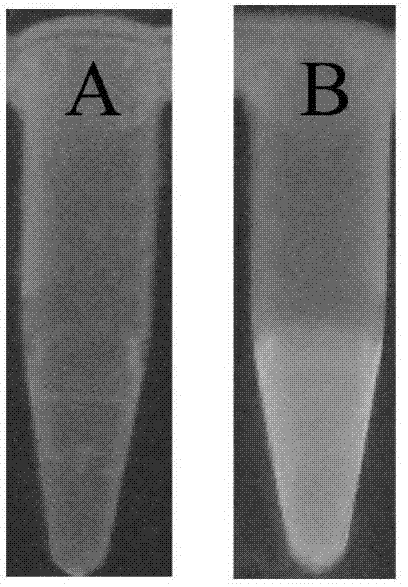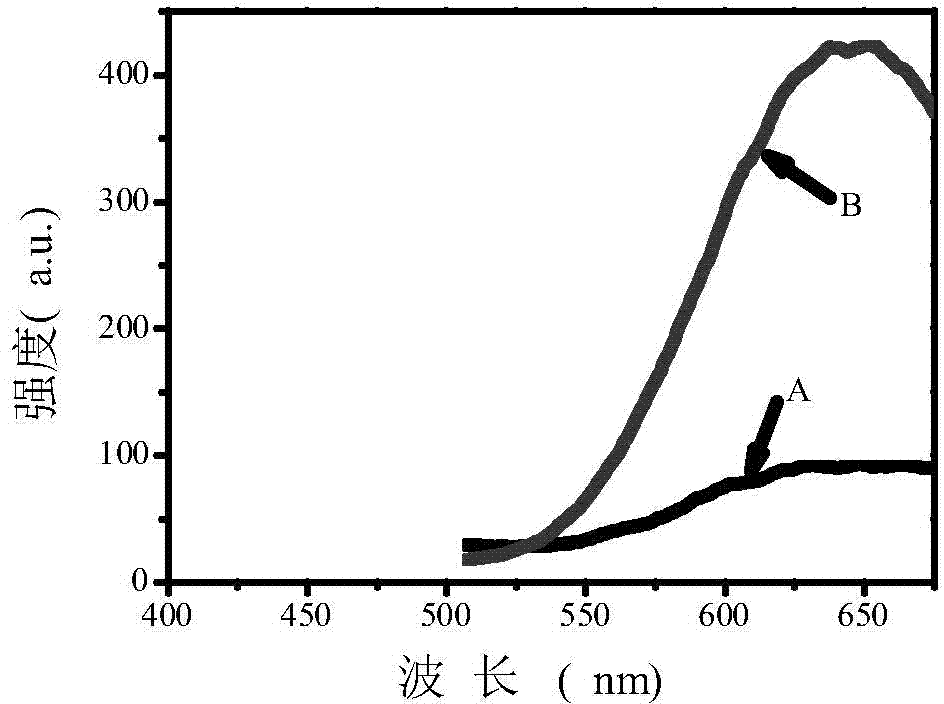Catalase fluorescence determination method based on gold nano-cluster probe
A technology of gold nanoclusters and catalase, which is applied in analytical chemistry and nanometer fields, can solve the problems of complex operation, insufficient precision, and poor repeatability, and achieve the effects of rapid preparation process, high sensitivity, and good specificity
- Summary
- Abstract
- Description
- Claims
- Application Information
AI Technical Summary
Problems solved by technology
Method used
Image
Examples
example 1
[0033] Add 0.6 mL of 0.5 mol / L sodium hydroxide solution and 0.4 mL of 0.02 g / L chloroauric acid solution to 4 mL of 0.08 mol / L N-acetyl-L-cysteine solution , mixed well, and placed in a 37°C constant temperature water bath to react for 2.5 h. After the reaction, the reaction solution was purified with a dialysis bag with a molecular weight cut off of 3500. The obtained gold nanocluster solution is colorless under visible light, and produces strong red fluorescence under ultraviolet light irradiation. Stored in the dark at 4°C, it can remain relatively stable for at least one month.
example 2
[0035] 0.025 ml of catalase solution with a concentration of 0.5 U / mL (containing HEPES——N-(2-hydroxyethyl)piperazine-N'-2-ethanesulfonic acid, concentration 20 mmol / L, pH=7.4 ) into 0.175 ml of a hydrogen peroxide solution with a concentration of 10 μmol / L (containing HEPES, a concentration of 20 mmol / L, pH=7.4), and reacted at 25°C for 90 minutes. 0.05 ml of Fe with a concentration of 0.9 mmol / L 2+ The solution (containing 40 mmol / L sulfuric acid) and 0.2 ml of the gold nanocluster solution prepared in Example 1 were sequentially added to the above reaction solution, shaken well and placed in a 25°C water bath for 10 minutes to react. Observed under ultraviolet light, the red fluorescence of the gold nanocluster solution without catalase was quenched after the Fenton reaction ( figure 1 A) in A), while the gold nanocluster solution recovered red fluorescence after adding catalase reaction ( figure 1 in B). figure 2 A gold nanocluster solution without adding catalase ( ...
example 3
[0037] Add 0.025 ml of 0.5 U / mL catalase solution (HEPES, 20 mmol / L pH=7.4) to 0.175 ml of 10 μmol / L hydrogen peroxide solution (HEPES, 20 mmol / L pH=7.4) in 25°C for 15-130 minutes. 0.05 ml of Fe with a concentration of 0.9 mmol / L 2+ The solution (containing 40 mmol / L sulfuric acid) and 0.2 ml of the gold nanocluster solution prepared in Example 1 were sequentially added to the above reaction solution, shaken well and placed in a 25°C water bath for 10 minutes to react. Such as image 3 As shown, after catalase catalyzed reaction for 90 minutes, the fluorescence intensity value F 650 The change is basically stable, so the catalase catalyzed reaction time is selected as 90 minutes.
PUM
 Login to View More
Login to View More Abstract
Description
Claims
Application Information
 Login to View More
Login to View More - Generate Ideas
- Intellectual Property
- Life Sciences
- Materials
- Tech Scout
- Unparalleled Data Quality
- Higher Quality Content
- 60% Fewer Hallucinations
Browse by: Latest US Patents, China's latest patents, Technical Efficacy Thesaurus, Application Domain, Technology Topic, Popular Technical Reports.
© 2025 PatSnap. All rights reserved.Legal|Privacy policy|Modern Slavery Act Transparency Statement|Sitemap|About US| Contact US: help@patsnap.com



